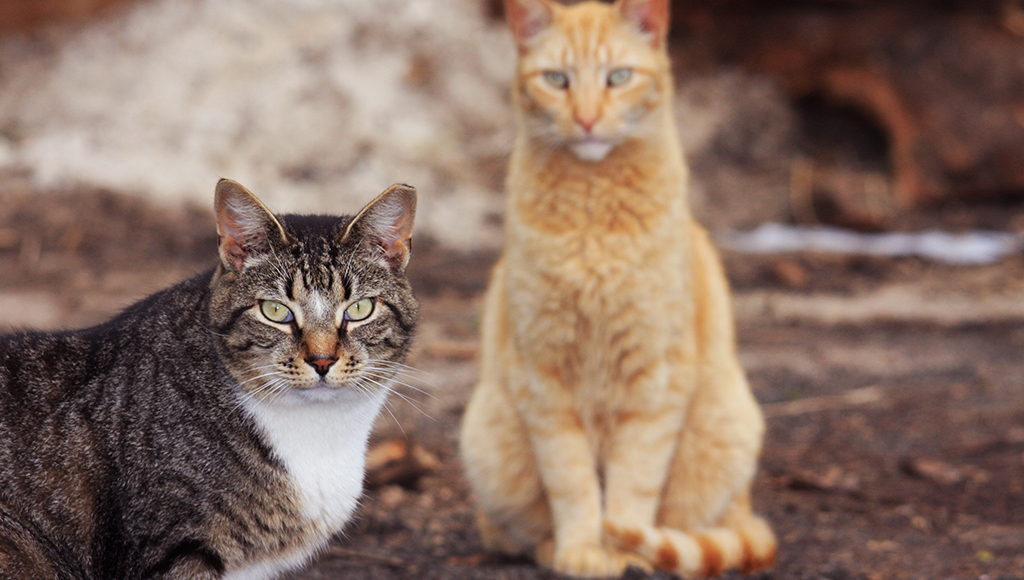Can Feral Cats be Trained?
With no human contact, these cats are often impossible to train.

Although you may not notice the difference just by looking at them, feral cats are different from stray cats. Stray cats are usually the product of a person’s irresponsibility or neglect. Irresponsibility could be defined as abandoning a cat to fend for itself. Stray cats can be timid, but are often easily tamed, simply because they've previously had human contact. Feral cats are cats that were probably born to wild parents and are wild themselves. True feral cats have had absolutely no human interaction and are very difficult to tame.
Feral cats are difficult to tame, thus making them undesirable indoor pets. There are many rescue organizations that are dedicated to the trapping and spaying and neutering of feral cat colonies. These organizations trap the cats, have them spayed and neutered and then release them where they were originally found; dedicating themselves to providing food to these colonies.
Feral cats are everywhere. You can find feral cats in rural areas as well as farm areas, abandoned buildings and even parks and alleyways. You might catch a glimpse of them, but chances are you would not be able to catch them easily. After all, they have not been around humans so any attempts at contact would make them shy away from you. If you have feral cats in your neighborhood, you may be wondering whether these animals can be kept as pets.
Taming a feral cat can be a difficult proposition for anyone, no matter how patient and committed they are to the challenge, simply because they are not accustomed to humans. Depending on the level of their interactions with humans, some cats might be classified as semi-feral, total feral or even a converted feral cat. Your potential success in socializing a feral cat depends on what classification it is. In addition, it takes a lot of time, a great deal of love and an incredible amount of patience to tame these cats.
If you find a cat that has been feral for its entire life, there is little to no chance of socializing it. With no human contact at all, these cats are overly independent and would never depend on a human for food or companionship. They have not experienced affection to any measurable degree, and so do not desire that type of attention to survive. You might have better success with a cat that is semi-feral. In these instances, they have had some limited human contact and may be receptive to your attention.
A converted feral cat would probably have the best chance at a normal life as someone’s pet. These cats were once domesticated, meaning that they probably started life as a pet and then were abandoned. The converted feral cat will more than likely eventually respond to human interactions such as love and affection, but this is not something that is going to occur quickly. Unfortunately most converted feral cats are abandoned a second time because those wishing to tame them get impatient.
If you want to attempt to tame a feral cat, remember that it can be hard work reaching out to the feral cat and getting them to trust you after being on their own. Sometimes, your efforts will not pay off for months, especially with older cats. If your attempts are a success, the rewards are well worth it because a strong bond can develop and loyalty and love is the reward.
If you believe you have the time and the love to attempt to tame a feral, there are some things to remember.
- First, these cats see you as an intruder and are very likely to spit, hiss, bite and claw. This is a normal response as they are defending themselves against a perceived predator – you. If they manage to get in a few bites or scratches, you should apply first aid immediately.
- After you have successfully trapped a feral cat, your very first step is to get it to the vet to be spayed or neutered and to check for any diseases it may carry. This is a necessary step and an absolute must if you have other pets in the house.
- After you have arrived home with your cat, you need to let it adjust to you and the surroundings by giving it a small, safe place to stay. Allow the cat to stay in a small bathroom or laundry room, where it does not feel overwhelmed.
- You will need to take time every day to spend time with the cat and allow the cat to adjust to you. Be patient with this step and gradually increase the length of time and frequency of these interactions. Not overwhelming the cat will be key in attempting to domesticate it.
Remember, not all feral cats can be socialized; however with love and patience, your time and efforts may be worthwhile.
Ready to start saving money on pet wellness care?
Then take a look at Mint Wellness, the pet wellness plan that provides fast reimbursement on routine pet care. Save on vaccinations, wellness exams, preventatives, dental, and more!
Learn More

